Kyoto’s food culture didn’t appear by accident. As Japan’s capital for over a thousand years, the city became a place where regional ingredients, court traditions, and religious practices came together to shape a distinct way of eating. Its inland geography, limited access to the sea, and abundance of fresh groundwater all played a role in how food was prepared and preserved.
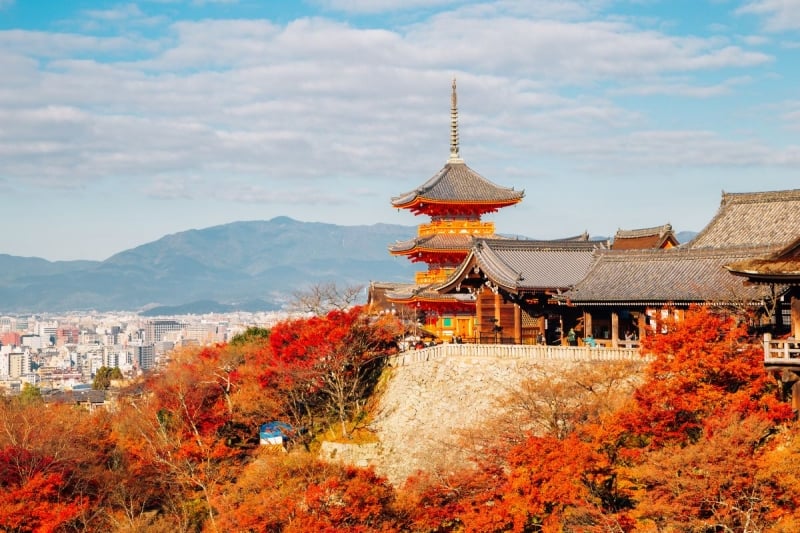
Image Credit: Sanga Park via Canva Pro
Many foundational styles of Japanese cuisine started here, including kaiseki, shojin ryori, and obanzai. These styles often focus on seasonal ingredients, natural flavours, and thoughtful presentation. But at its core, Kyoto’s food is not about appearance. It is about care, balance, and attention to detail. The following dishes offer a look into that quiet approach to cooking and eating.
Also read: A Guide to Goshuin Collecting in Japan: The Quiet Art of Shrine Stamps
1. Yudofu: Simple, Seasonal Warmth
Yudofu is one of Kyoto’s most iconic dishes, but it’s also one of its most unassuming. At its core, yudofu is just tofu simmered in a light kombu (kelp) broth, served with dipping sauces like soy sauce, ponzu, or a touch of mustard. There are no elaborate garnishes or surprise ingredients. But that simplicity is exactly the point.
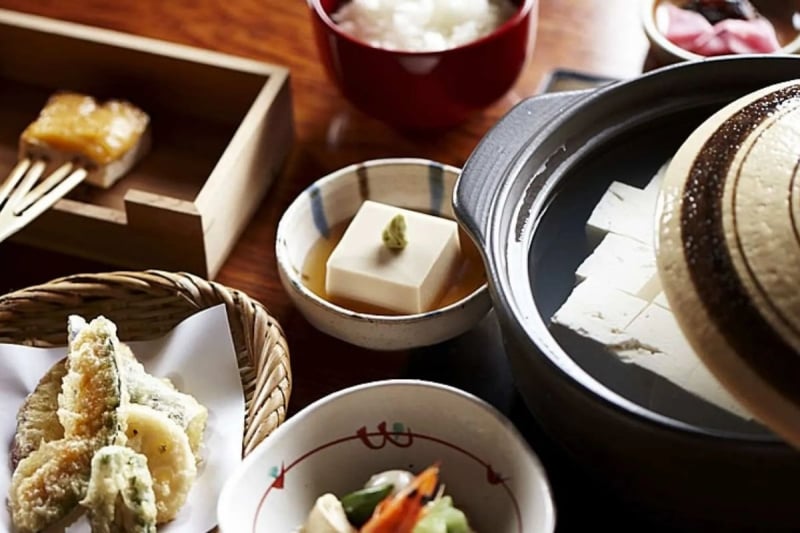
Image Credit: Shimizu Junsho Okabeya Official Website
The dish has deep roots in Kyoto’s Buddhist traditions, especially around temple areas like Nanzenji and Tenryuji, where it was first eaten by monks as part of a plant-based, seasonal diet. With no meat or strong flavours, it relies entirely on the quality of ingredients, especially the tofu, which is often made with Kyoto’s soft, mineral-rich water. The result is tofu that’s tender, slightly sweet, and subtly creamy, without needing anything else to stand out.
Yudofu is typically eaten in winter when the warmth of the broth offers comfort against the cold. In some temple restaurants, it’s served with quiet views of gardens or flowing streams, reinforcing the dish’s role not just as a meal, but as a moment of calm.
2. Obanzai: Everyday Elegance
Obanzai is the name given to Kyoto-style home cooking. It’s not meant to impress with fancy techniques or rare ingredients. Instead, it reflects what Kyoto households cook on an ordinary day, which usually consists of a small assortment of dishes made with seasonal vegetables, local produce, and simple seasoning.

Image Credit: Nesnad via Wikimedia Commons
To be considered obanzai, more than half of the ingredients must be produced or processed in Kyoto. Nothing is wasted, and every part of the vegetable or fish is used in some way. You’ll often see simmered kabocha (Japanese pumpkin), boiled greens with sesame, or grilled mackerel, arranged in small bowls and served alongside miso soup and rice.
What makes obanzai special is its quiet practicality. Passed down through generations, it’s a cuisine of care and rhythm, reflecting Kyoto’s focus on balance and appreciation of what’s available.
3. Saba-zushi: History in a Bite

Image Credit: City Foodsters via Wikimedia Commons
Saba-zushi is a type of pressed sushi made with mackerel that has been salted and cured in vinegar. It developed out of necessity: Kyoto is landlocked, and in the past, fresh fish couldn’t be delivered to the city without spoiling. To bring seafood in from Wakasa Bay, merchants would preserve it with salt before sending it along what became known as the Saba Kaido, or Mackerel Highway.
By the time the fish arrived in Kyoto three days later, it had reached the perfect level of saltiness. Local chefs paired it with vinegared rice, creating saba-zushi. Unlike the soft texture of Tokyo-style nigiri, saba-zushi is firmer and more flavourful, with a slightly tangy edge that pairs well with pickled ginger.
Today, saba-zushi is still served in many traditional restaurants and tea houses, especially during festivals. It’s a reminder that Kyoto’s food is often shaped not by abundance, but by how it learns to work with limits.
Also read: Where to Buy the Best Matcha in Kyoto (A Matcha Lover’s Guide)
4. Shojin Ryori: Eating With Attention
Shojin ryori is a type of vegetarian Buddhist cuisine, originally brought to Japan from China by Zen monks. In Kyoto, where many of Japan’s most important temples are located, it developed into a refined culinary tradition based on seasonal vegetables, tofu, grains, and plant-based broths.

Image Credit: GO Tokyo Official Website
There is no garlic, onion, or meat. Instead, the dishes rely on subtle variations in texture and natural umami, like creamy goma dofu (sesame tofu), lightly simmered root vegetables, and pickled greens. Each component is carefully placed and meant to be eaten slowly.
Shojin ryori is often served in temple restaurants or as part of a stay at a shukubo (temple lodging). Beyond its nutritional value, it reflects a way of eating rooted in mindfulness, ethics, and care. It’s not flashy, but it stays with you.
5. Tsukemono: The Patience of Pickling
Tsukemono, or Japanese pickles, is an essential dish found in almost every Kyoto meal. Pickles cleanse the palate, preserve seasonal ingredients, and offer contrast to milder dishes like tofu or rice.
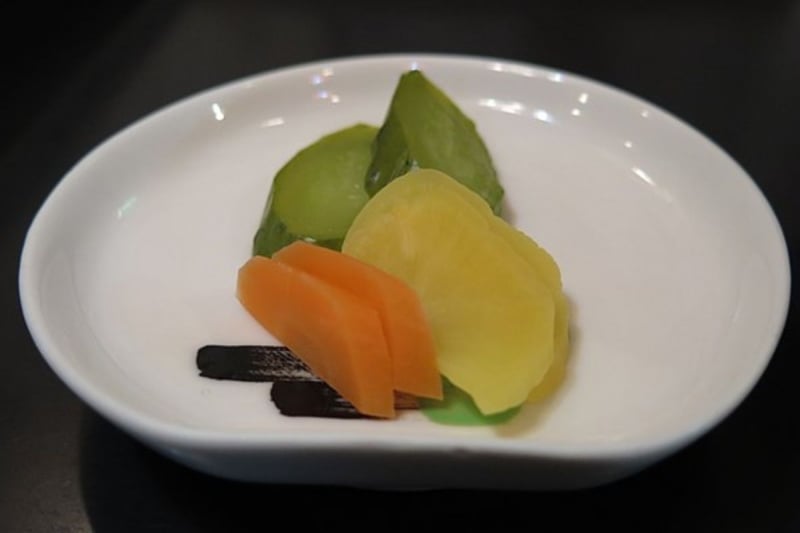
Image Credit: Douglas Perkins via Wikimedia Commons
Kyoto is especially known for three types of tsukemono: shibazuke (a mix of cucumber and eggplant pickled with red shiso leaves), senmaizuke (thin-sliced turnip pickled with kelp and vinegar), and sugukizuke (a type of fermented turnip). These pickles can be found in bento boxes, set meals, and market stalls across the city, especially in Nishiki Market.
Before refrigeration, pickling was a practical necessity. In Kyoto, it became something more—an art of preservation that highlights both the ingredient and the passage of time.
Also read: 7 Best Ryokans in Kyoto for Autumn 2025: Garden Views, Onsen & Kaiseki
6. Nishin Soba: A Convergence of Histories
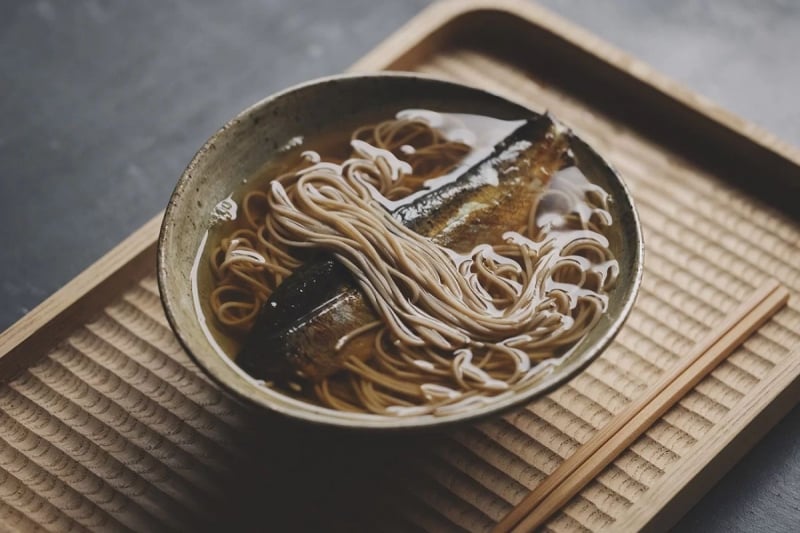
Image Credit: Honke Owariya Official Website
Nishin soba is a bowl of hot buckwheat noodles topped with sweet-simmered herring. It’s a uniquely Kyoto dish, rooted in trade and movement. The herring originally came from Hokkaido, brought to Kyoto by Kitamae ships during the Edo period. To survive the journey, the fish was dried and preserved before being rehydrated and cooked in a soy-based sauce.
The soba is typically served in a light dashi broth, with the marinated herring laid across the top. The result is comforting but complex with soft noodles, savoury broth, and a rich piece of fish that tastes slightly sweet.
Nishin soba is especially popular in autumn and winter, when warm, hearty dishes are most welcome. Like many Kyoto foods, it’s shaped by necessity but refined by habit, turning a preserved ingredient into something soothing and satisfying.
7. Yatsuhashi: A Sweet with Local Roots
Yatsuhashi is a traditional Kyoto sweet made from rice flour, sugar, and cinnamon. The “raw” version, called nama yatsuhashi, is a soft mochi-like skin folded into a triangle and filled with sweet red bean paste. The baked version is crisp and often shaped like a small musical harp.
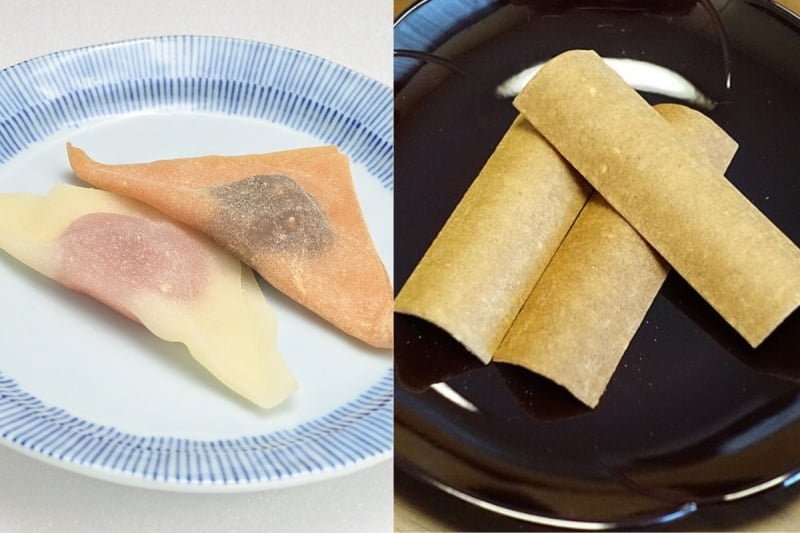
Image Credit (L-R): Ocdp via Wikimedia Commons; PekePON via Wikimedia Commons
The name itself honours Yatsuhashi Kengyo, a 17th-century Kyoto musician credited with popularising the koto (a Japanese zither instrument). Today, yatsuhashi is sold all over the city, especially near tourist spots like Kiyomizu-dera and Gion. It’s one of the most common omiyage (souvenir snacks) people bring back from Kyoto.
Though it’s simple, yatsuhashi captures something important: how Kyoto ties food to place, memory, and the everyday act of giving.
Also read: A Guide to Regional Food in South Korea: Iconic Local Dishes You Should Eat in Each City
Final thoughts

Image Credit: Japan Photos via Canva Pro
Food is never really just food. In Kyoto, it carries traces of the city’s history, geography, and way of life. The softness of tofu, the salt of preserved mackerel, the quiet sharpness of pickled vegetables all reflect a deeper philosophy of balance, seasonality, and care.
These dishes are not just meals but moments. They speak to a way of eating that values attention over abundance and meaning over presentation. To eat in Kyoto is to listen closely to what the food is saying, and to take part, even briefly, in a slower, more intentional rhythm of life.




